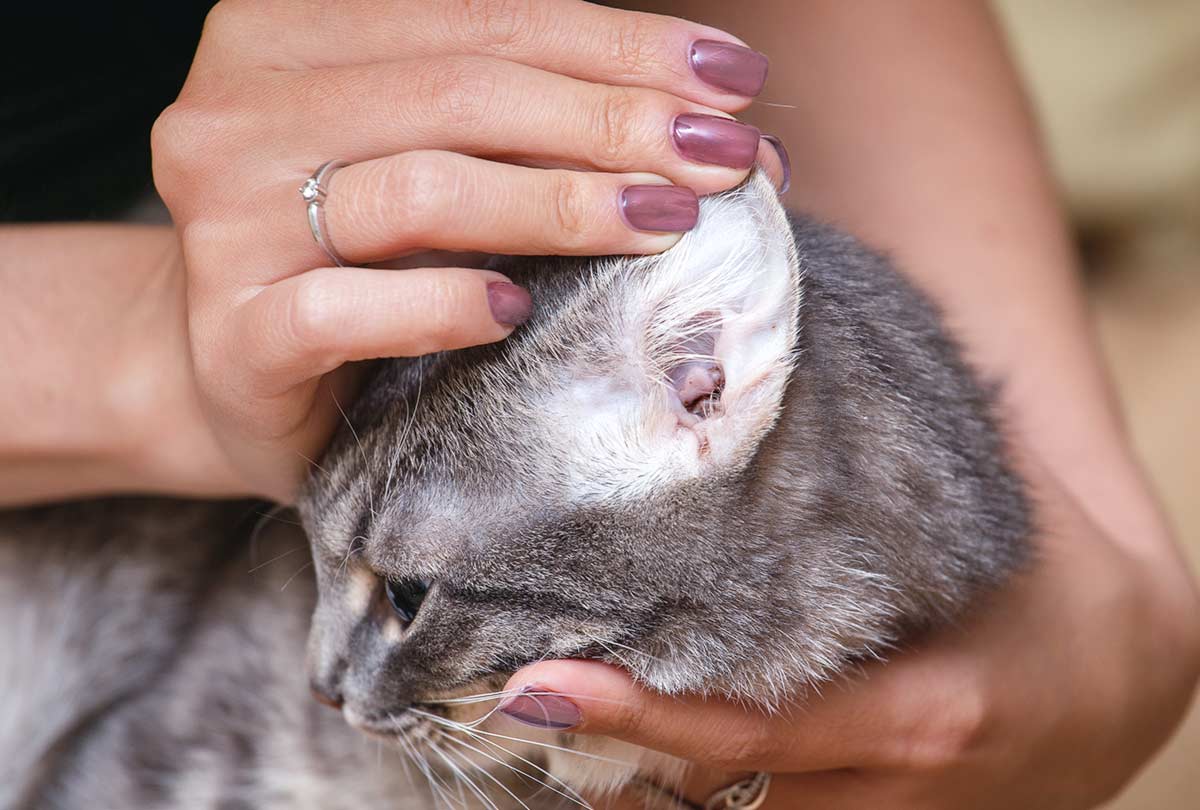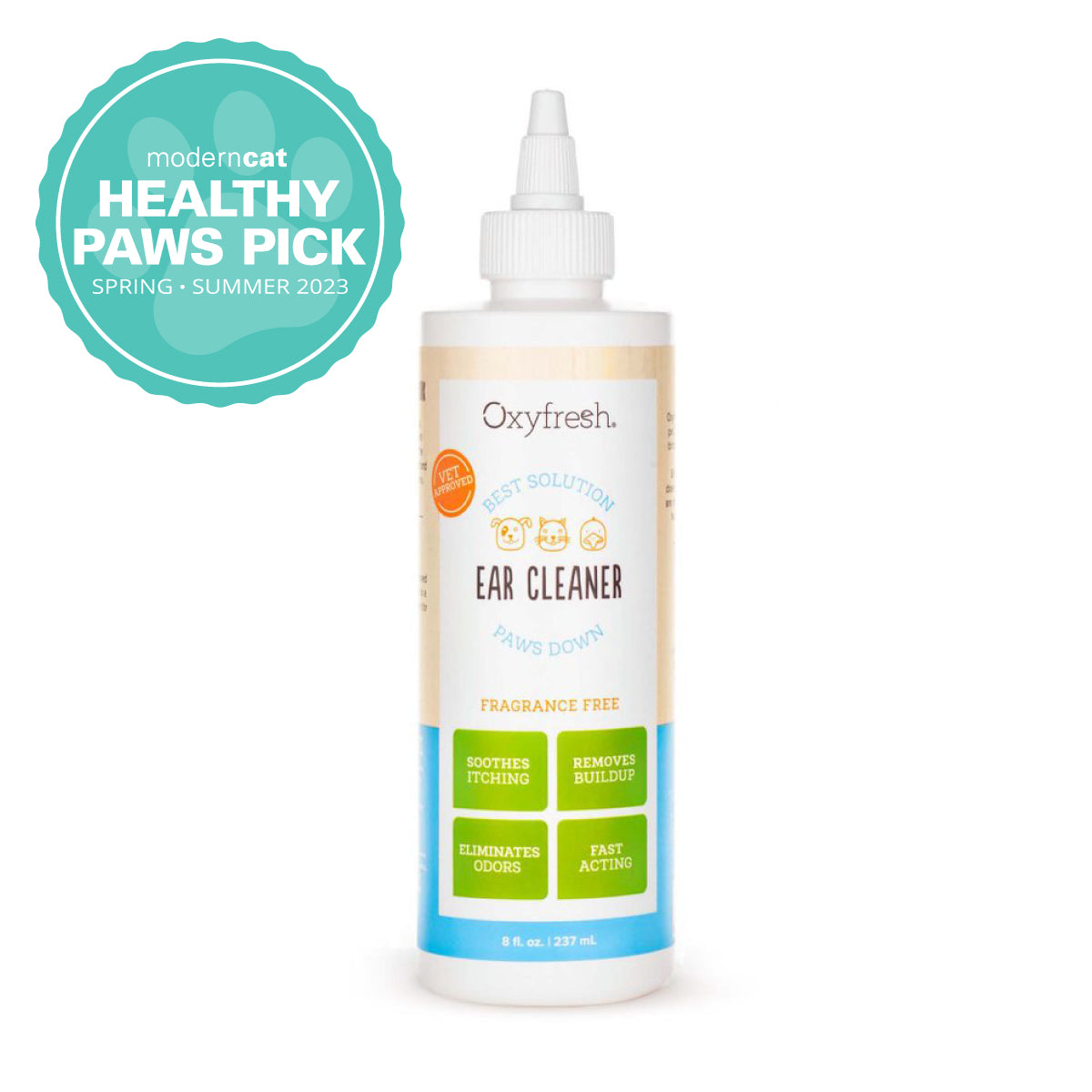Ear mites often come with the territory of being a cat parent, especially if you have an outdoor cat or kitten. Cat ear mites can be very uncomfortable for our feline friends, leading to intense itching and ear infections.
If you suspect you’re dealing with mites in your cat’s ears, deep breath. We’re going to tell you what to look for, and most importantly, what to do to send these pesky parasites packing.
What Are Cat Ear Mites?
Ear mites are tiny parasites (they look like little crabs under a microscope) that love to set up camp inside a cat’s ears and chow down on the oils and skin cells inside. They have a three-week lifecycle going from egg to reproducing adult, which is why it takes diligent work to eliminate cat ear mites.
Ear mites easily spread via direct contact among pets or through the environment (e.g. shared blankets). As many as 9 in 10 cats will get ear mites in their lifetimes. They’re especially common in kittens because of their close living quarters. Shelter cats and outdoor cats are also more likely to get ear mites because they "socialize" more.
Can cat ear mites spread to other pets?
Yes! Ear mites are not breed specific and can easily spread to other pets in the home – cats, dogs, ferrets, rabbits, and even the gerbil. That’s why if your cat has ear mites, all pets in the home should be treated for mites.
How Can I Tell If My Cat Has Ear Mites?
If only cats could talk and tell us all about their troubles – you know, with their ears, our choice of wet food, and their general dismay with the dog – but until that happens, it’s up to us to read between the lines to see if we’ve got a cat ear mite infestation on our hands. (Not literally – ear mites generally don’t prefer humans as hosts.) Instead, look for any of these five symptoms ...
5 Signs of Ear Mites in Cats
#1. Cat Ear Wax Looks Like Coffee Grounds
The best part of waking up ... OK, this may not make you crave a cup of coffee, but any dark, crumbly discharge that resembles coffee grounds is a sure sign of mites in cat ears. This ear debris is composed of ear wax, blood and digestive materials left behind by the mites. Yuck!
#2. Excessive Ear Scratching
If having little crab-like parasites running around inside your ear and leaving their droppings behind sounds uncomfortable, it is! That’s why ear scratching is a top sign of mites in cats. The scratching can be so intense that they get scabbing, redness and inflammation around the ears. In severe cases, blood vessels in the ear can rupture.
#3. Ear Odor
If you notice a strong odor coming from your cat’s ears, this could be from the mess of the mites themselves or it could be that your cat has an ear infection. While cats usually tend to have pretty healthy ears, if a cat does come down with an ear infection, mites are to blame in 50% of those cases.
#4. Head Shaking
Mites in cat ears will make felines feel like they have something lodged in their ears. In addition to nonstop scratching, you’ll likely see some frequent, if not violent, head shaking going on.
#5. Full-Body Scratching
While ear mites prefer the environment of the ear as their "home tasty home," mites do sometimes travel to other parts of the cat (vacation home!) and live on their skin surface, causing itchiness and irritation. That’s why, in addition to ear treatment, you’ll want to make sure your cat gets a parasitic shampoo treatment.
Can You Actually See Ear Mites in Cats’ Ears?
Ear mites are barely visible to the naked eye, but you can outsmart those mighty mites and spot them if you know what to look for. Because other cat ear problems like bacterial or yeast ear infections cause similar symptoms, having a line of vision on the mites will let you know exactly what you’re dealing with.
I spy with my little eye ... cat ear mites?
Use a cotton ball to remove some of the debris from your cat’s ear. Spread it on a piece of dark paper, then look at it under a bright light with a magnifying glass. Don’t have a home magnifying glass like it’s 1984? No prob. You can also take a video on your phone and then enlarge it. If there are mites in your cat’s ears, they’ll look like tiny white specks scurrying around in the debris.
Treatment of Ear Mites in Cats
We totally get it. Visits to the vet can add up. And there ARE over-the-counter cat ear mite treatments that are safe and effective if you want to go that route.
The downside of OTC? Sometimes those meds take longer to eradicate the ear mites in cats versus a medication that’s vet prescribed. For many, a trip to the vet for a one- or two-time treatment versus two weeks of wrestling with their cats at home to put drops in their ears is the best money they’ll ever spend!
Tip: if you’re treating your cat’s ear mites at home, be sure to follow the dosage schedule. Remember – mites have a three-week lifecycle and can start a new infestation as the eggs hatch if you quit the treatment routine too soon. During this time, you'll also want to vacuum regularly and wash blankets/bedding in hot water.
What if I think my cat has an ear infection?
The other compelling reason to visit the vet is if your cat has an ear infection. Cat ear infections are very painful and most likely won’t go away on their own. Because ear infections have similar symptoms as mites (and are often caused by mites), it’s always best to let the experts take a look. And, if you’re treating your cat for mites and it’s really just an ear infection, the mite medication could actually make the ear infection worse.
Successful Ear Mite Treatment Starts With a Clean Ear
Whether you decide to treat your cat’s ear mites at home or make an appointment with the vet, the first thing you’ll want to do is clean your cat’s ears. This will benefit your cat in three ways:
- It will help remove many of the mites and their debris. Make sure your garbage bag is right next to you and immediately dispose of it. Weather permitting, you may even want to do this outside.
- It will help soothe the itch and irritation happening in your cat’s ears.
- Removing the debris will help the mite medication penetrate into the ear. Otherwise, it will just sit on top of the gunk and not do what it’s supposed to do.
Outlook for cats with ear mites
Cats respond very well to ear mite treatment and life will likely be back to normal soon. But left untreated, ear mites in cats can lead to bacterial infections, damage to their ear canals, ongoing skin problems, and even deafness. So don’t take a wait-it-out approach. If your cat has ear mites, begin treatment right away, starting with cleaning their ears so they can get some much-needed soothing relief. At the same time, you'll be removing lots of the mite eggs and debris. Yay!
Why Oxyfresh Pet Ear Cleaner Is a Must for Fighting Ear Mites
When your cat is battling mites, they can be in serious discomfort. Cat ear cleaners with alcohol, fragrance and peroxides can sting, burn and bubble up in your cat’s ears, freaking them out and making their discomfort worse. But with Oxyfresh, those worries are off the table because it’s free of all that junk! Oxyfresh's USA-made Pet Ear Cleaner is gentle, hypoallergenic, and the cat’s meow at removing stubborn wax and ear mite debris. Best of all, it gives cats immediate relief from all that itching caused by ear mites and ear infections.
Cats Give Oxyfresh Pet Ear Cleaner 2 Paws Up
- Immediate relief: Fast-acting formula stops itching right in its tracks while gently cleansing away irritants and pampurring their tender ears.
- Removes buildup: Cleaning your cat’s ears is the #1 step in taking on ear mites (and winning). Gentle plant-based surfactants power through mite debris without leaving oily residue behind.
- Eliminates ear odors: Oxyfresh’s proprietary odor- and bacteria-fighting ingredient Oxygene® helps freshen and soothe cat ears, fast. No other cat ear cleaner has it!
- Hypoallergenic ear cleaner: This vet- and groomer-loved formula is incredibly gentle with no burning alcohol, irritating parabens, bubbling peroxides, or weird antiseptic fragrances or oils.






